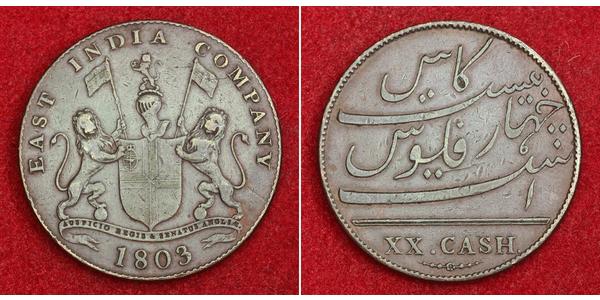(售价 $10.0)
1803, British India, Madras Presidency. Beautiful Copper 20 Cash Coin. XF!
Region: India Mint Year: 1803 References: KM-321. Denomination: 20 Cash Condition: Scattered bag-marks and small scratches, otherwise XF! Weight: 12.71gm Material: Copper Diameter: 30mm
Obverse: Shield with brBritishrms, topped by a lion, supported by two lions, which are holding flags. All on base with date (1803) and motto. Banner Legend: AUSP: REG: & SEN. ANG: ("Under the auspices of the king and senate of England.") Legend: EAST INDIA COMPANY
Reverse: Bi-lingual (Persian/English) inscription (XX.CASH).
The East India Company (also the East India Trading Company, English East India Company, and then the British East India Company) was an early English joint-stock company that was formed initially for pursuing trade with the East Indies, but that ended up trading mainly with the Indian subcontinent and China. The oldest among several similarly formed European East India Companies, the Company was granted an English Royal Charter, under the name Governor and Company of Merchants of London Trading into the East Indies, by Elizabeth I on 31 December 1600. After a rival English company challenged its monopoly in the late 17th century, the two companies were merged in 1708 to form the United Company of Merchants of England Trading to the East Indies, commonly styled the Honourable East India Company, and abbreviated, HEIC; the Company was colloquially referred to as John Company, and in India as Company Bahadur (Hindustani bahadur, "brave").
The East India Company traded mainly in cotton, silk, indigo dye, saltpetre, tea, and opium. However, it also came to rule large swathes of India, exercising military power and assuming administrative functions, to the exclusion, gradually, of its commercial pursuits. Company rule in India, which effectively began in 1757 after the Battle of Plassey, lasted until 1858, when, following the events of the Indian Rebellion of 1857, and under the Government of India Act 1858, the British Crown assumed direct administration of India in the new British Raj. The Company itself was finally dissolved on 1 January 1874, as a result of the East India Stock Dividend Redemption Act.
The Company long held a privileged position in relation to the English, and later the British, government. As a result, it was frequently granted special rights and privileges, including trade monopolies and exemptions. These caused resentment among its competitors, who saw unfair advantage in the Company's position. Despite this resentment, the Company remained a powerful force for over 200 years over India.
The Madras Presidency, officially the Presidency of Fort St. George and also known as Madras Province, was an administrative subdivision of British India. At its greatest extent, the presidency included much of southern India, including the present-day Indian State of Tamil Nadu, the Malabar region of North Kerala, Lakshadweep Islands, the Coastal Andhra and Rayalaseema regions of Andhra Pradesh, Ganjam, Malkangiri, Koraput, Rayagada, Nabarangapur and Gajapati districts of southern Orissa and the Bellary, Dakshina Kannada, and Udupi districts of Karnataka. The presidency had its winter capital at Madras and summer capital at Ootacamund.
In 1639, the English East India Company purchased the village of Madraspatnam and one year later it established the Agency of Fort St George, precursor of the Madras Presidency, although there had been Company factories at Machilipatnam and Armagon since the very early 17th century. The agency was upgraded to a Presidency in 1652 before once more reverting to its previous status in 1655. In 1684, it was re-elevated to a Presidency and Elihu Yale was appointed as President. In 1785, under the provisions of Pitt's India Act, Madras became one of three provinces established by the East India Company. Thereafter, the head of the area was styled "Governor" rather than "President" and became subordinate to the Governor-General in Calcutta, a title that would persist until 1947. Judicial, legislative and executive powers rested with the Governor who was assisted by a Council whose constitution was modified by reforms enacted in 1861, 1909, 1919 and 1935. Regular elections were conducted in Madras up to the outbreak of the Second World War in 1939. By 1908, the province comprised twenty-two districts, each under a District Collector, and it was further sub-divided into taluks and firqas with villages making up the smallest unit of administration.
Following the Montague-Chelmsford reforms of 1919, Madras was the first province of British India to implement a system of dyarchy, and thereafter its Governor ruled alongside a Prime Minister. In the early decades of the 20th century, many significant contributors to the Indian independence movement came from Madras. With the advent of Indian independence on August 15, 1947, the Presidency was dissolved. Madras was later admitted as a state of the Indian Union at the inauguration of the Republic of India on January 26, 1950, and was reorganized in 1956.














